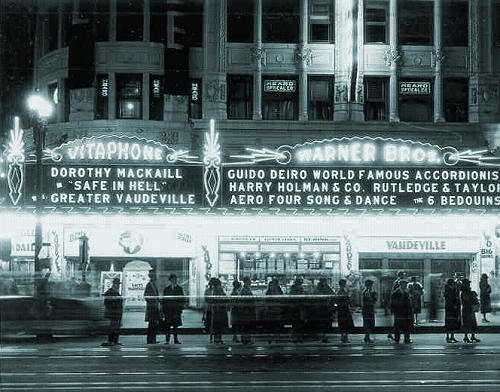Guido Deiro was the first accordionist to be featured in a sound film.
Vitaphone #2968, titled GUIDO DEIRO: The World's Foremost Piano-Accordionist was filmed in Burbank, California at the Warner Brothers studio in 1928. He performed two songs in the film, Romeo and Juliet and Drigo's Serenade. * Restoration of this historic sound film was completed at the UCLA film laboratory and was shown on the Turner Classic Movie
Channel in 2002.
In this film Guido performs two pieces: (1) The Overture from I Capuleti ei Montecchi by the Italian opera composer Vincenzo Bellini (1801-1835), and (2) the Serenade from Les Millions D'Arlequin by the Italian composer and conductor Riccardo Drigo (1846-1930).
This film--recently restored by the University of California Film Library with funding by Count Guido Roberto Deiro--displays the great artistry, virtuosity, musicianship, and stage presence of the first great star of the piano-accordion at the age of 42 at the height of his fame. In the introduction to Bellini's overture Guido uses his left-hand air button (or bar) to close his bellows in order to be better situated for the next passage. In those days accordion air-button valves were much larger and allowed a great deal of air to pass through quickly.
During Drigo's Serenade Guido uses his augmented chord buttons in the left hand, as he was one of the few accordionists to own such an accordion with an extra row of augmented chord buttons. Look carefully and you will see the black cloth Guido used to protect his tuxedo pants from wear and tear by the bellows.
Although this film is short by contemporary standards (a little more than six minutes), it is of great musical and historical interest, as it shows in no uncertain terms the greatness of the man who in 1910 inaugurated the fifty-year Golden Age of the Accordion.

Theater marquee of Deiro's Vitaphone premiere at the Warner Bros. Theatre
|
The Vitaphone of Warner Bros. -- developed by Western Electric and Bell Labs -- was the first talking picture system to be put into commercial use and was simply an evolution of the old-style phonograph method of projecting sound pictures. Vitaphone synchronized the soundtrack portion on 16 inch shellac record discs with the picture portion on 35mm film in a single projector. Each disc corresponded to one reel of film, or about ten minutes. The records used in this system are much larger than ordinary phonograph records, they rotate more slowly, and the needle travels from the center to the outside, instead of from the outside inward, as in the ordinary phonograph. In addition, the grooves in a Vitaphone disc were less rigid in order to enhance sonic quality. However, each disc could be used only for twenty plays before replacement, thus the check boxes on the label.
The Vitaphone camera was linked directly to a turntable that recorded sound onto a blank phonograph disc. This system generated a great deal of noise while in operation, so the entire apparatus was housed in a soundproof booth.
The projection of a Vitaphone film required very precise synchronization of disc and film. Each reel of film had a "start" frame, and the projectionist had to line up that frame in the projector's gate. The disc would be cued on the attached turntable by placing the stylus at the first groove, marked with an arrow etched into the record. At the flip of a switch, the film and disc would accelerate to their appropriate playing speed.
Images courtesy of the Library of Congress.





